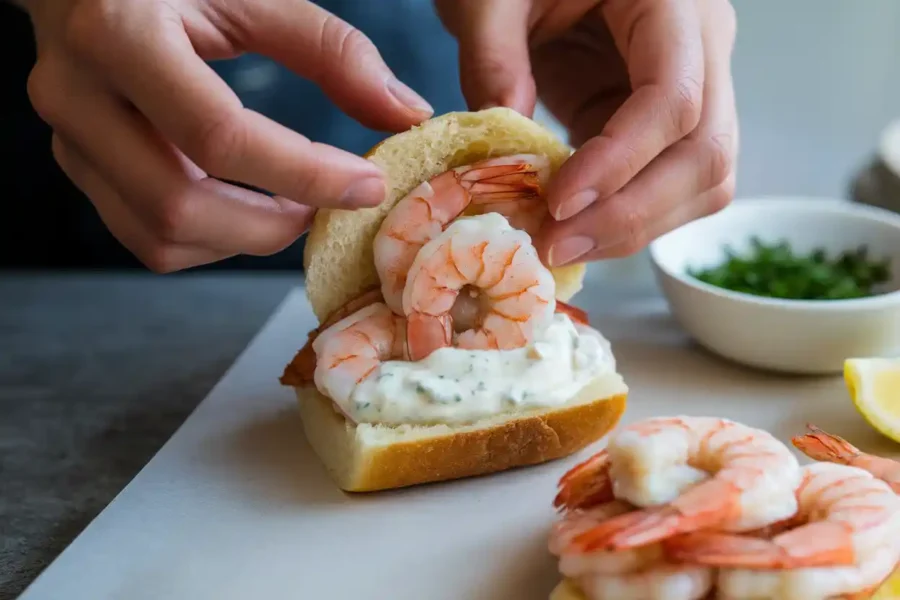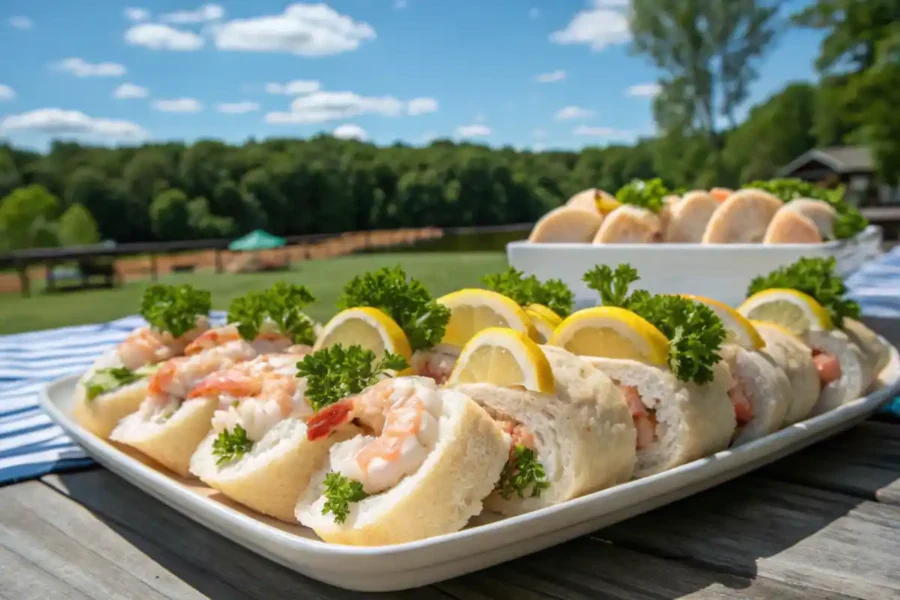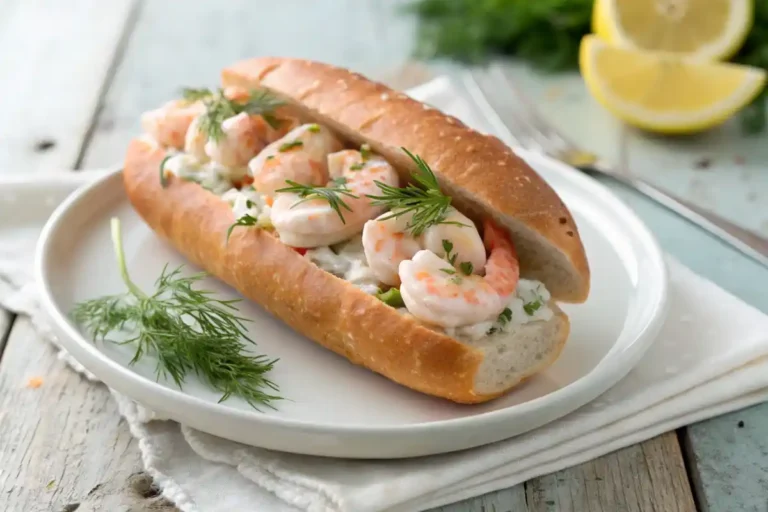When it comes to iconic seafood dishes, the shrimp roll stands out as a beloved favorite. With its juicy shrimp, creamy dressing, and buttery bun, it’s a treat for the taste buds. This guide dives into everything you need to know about shrimp rolls from their origins to how to make them at home. Whether you’re a seafood enthusiast or new to the dish, this article will walk you through every detail to craft the perfect roll. Let’s get rolling!
Table of Contents
Introduction to Shrimp Rolls
What Is a Shrimp Roll?
A shrimp roll is a seafood dish that combines succulent, cooked shrimp with a flavorful dressing, typically served in a soft, toasted bun. It’s often considered a close cousin to the lobster roll, but shrimp rolls have their unique charm. They’re lighter, easier to make, and more budget-friendly, making them an accessible option for seafood lovers everywhere.
This dish originated in New England, where fresh seafood is a staple. Traditionally served cold, shrimp rolls feature a creamy dressing made with mayonnaise, herbs, and a hint of lemon juice. The shrimp filling is stuffed into a buttery brioche or hot dog-style bun, creating a simple yet indulgent sandwich.
The Popularity of Shrimp Rolls Globally
While shrimp rolls have their roots in American coastal cuisine, they’ve gained popularity worldwide. Today, you can find variations in different cuisines, from Asian-inspired versions with spicy mayo to Mediterranean takes with olive oil and fresh herbs. Their versatility and ease of preparation make them a favorite at picnics, barbecues, and seafood restaurants alike.
Shrimp rolls have also become a staple in modern food culture, celebrated for their balance of flavors and textures. With plump shrimp, creamy dressing, and a toasted bun, it’s no wonder this dish has captured hearts across the globe.
In the next section, we’ll dive into the ingredients that make a shrimp roll truly unforgettable. Stay tuned to discover what you need to whip up this delicious seafood delight!
Ingredients and Preparation
Essential Ingredients for Shrimp Rolls
Creating the perfect shrimp roll starts with gathering fresh and high-quality ingredients. Here’s what you’ll need:
- Shrimp: Opt for medium to large-sized shrimp, peeled and deveined. Fresh shrimp are ideal, but frozen works if properly thawed.
- Buns: Brioche or split-top hot dog buns are classic choices. Their softness and slight sweetness complement the shrimp filling.
- Dressing: A creamy mixture of mayonnaise, lemon juice, and a touch of Dijon mustard adds flavor and binds the shrimp together.
- Seasonings: Salt, pepper, and optional spices like paprika or Old Bay seasoning for a zesty kick.
- Herbs: Fresh dill or parsley for garnishing.
Each ingredient plays a crucial role in crafting a well-balanced shrimp roll that bursts with flavor and texture.
Here’s a precise table of ingredients for the Shrimp Roll Recipe, including exact measurements:
| Ingredient | Quantity | Notes |
|---|---|---|
| Shrimp | 1 pound (450g) | Medium to large, peeled and deveined, fresh or thawed frozen. |
| Brioche or Hot Dog Buns | 4 buns | Split-top preferred, buttered and toasted. |
| Mayonnaise | ½ cup (120ml) | Forms the creamy base of the dressing. |
| Lemon Juice | 1 tablespoon (15ml) | Freshly squeezed for best flavor. |
| Dijon Mustard | 1 teaspoon (5ml) | Adds a mild tanginess to the dressing. |
| Salt | ½ teaspoon (2.5g) | Adjust to taste. |
| Black Pepper | ¼ teaspoon (1g) | Freshly ground for better flavor. |
| Paprika or Old Bay Seasoning (Optional) | ½ teaspoon (2.5g) | For a zesty kick. |
| Fresh Dill or Parsley | 1 tablespoon (5g) | Chopped, for garnish and extra freshness. |
| Butter | 2 tablespoons (30g) | For toasting the buns. |
Choosing the Best Shrimp
The type and quality of shrimp can make or break your shrimp roll. Here are some tips:
- Fresh vs. Frozen: Fresh shrimp are unbeatable in flavor, but frozen shrimp can be just as good when thawed properly. Avoid pre-cooked shrimp for better texture.
- Wild-Caught vs. Farm-Raised: Wild-caught shrimp tend to have a firmer texture and richer flavor compared to farm-raised varieties.
- Size Matters: Medium or large shrimp work best as they provide a hearty bite without overwhelming the bun.
If you’re curious about other seafood recipes, check out Tasty Sara’s Lemon Tiramisu Recipe for a unique dessert pairing with your seafood dish.
Step-by-Step Cooking Process
Preparing and Cooking the Shrimp
Cooking shrimp for your shrimp roll is quick and easy. Follow these steps:
- Boil or Sauté: Boil shrimp in salted water for 2–3 minutes until pink and opaque, or sauté them in olive oil for added flavor.
- Chill the Shrimp: After cooking, transfer the shrimp to an ice bath to cool quickly. This step ensures they remain tender and juicy.
- Chop or Keep Whole: Depending on your preference, dice the shrimp into bite-sized pieces or keep them whole for a chunkier roll.
Making and Assembling the Rolls
Once the shrimp are ready, it’s time to assemble:
- Toast the Buns: Butter the inside of each bun and lightly toast them on a skillet for a golden-brown finish.
- Mix the Filling: Combine shrimp, dressing, and seasonings in a bowl. Adjust the flavors to your liking.
- Stuff the Buns: Generously fill each bun with the shrimp mixture, making sure every bite is packed with flavor.

Serving Suggestions
Pair your shrimp roll with classic sides like coleslaw, potato chips, or a crisp green salad. Add a lemon wedge for a refreshing squeeze of citrus before eating. These simple steps ensure your shrimp roll is as visually appealing as it is delicious!
Variations and Customizations
Regional Variations of Shrimp Rolls
The shrimp roll has evolved into a versatile dish with regional twists, each bringing its unique flair:
- New England Style: The classic version features chilled shrimp, a mayonnaise-based dressing, and toasted split-top buns. Fresh dill or parsley is often added for a refreshing touch.
- Asian-Inspired Shrimp Rolls: These rolls incorporate flavors like sesame oil, ginger, and sriracha. Swap the brioche buns for steamed bao buns for an authentic experience.
- Mediterranean Influence: Toss shrimp with olive oil, lemon, and fresh oregano. Add cucumbers and tomatoes to the roll for a vibrant, zesty flavor.
These regional adaptations demonstrate how simple tweaks can transform a shrimp roll into a globally inspired delight.
Dietary Adaptations and Flavor Enhancements
If you’re catering to dietary needs, the shrimp roll can easily be adjusted:
- Gluten-Free Options: Use gluten-free buns or lettuce wraps to replace traditional bread.
- Low-Calorie Alternatives: Substitute mayonnaise with Greek yogurt for a healthier dressing.
- Spicy Kicks: Add chipotle or cayenne pepper to the dressing for a fiery twist.
By tailoring the shrimp roll to personal preferences or event themes, you can create a dish that’s both unique and crowd-pleasing.
Nutritional Value of Shrimp Rolls
Are Shrimp Rolls High in Calories?
A typical shrimp roll is moderately calorie-dense, but its nutritional profile largely depends on the ingredients:
- Calories: On average, a shrimp roll contains 250–400 calories. Opt for whole-grain buns and light dressings to keep it on the healthier side.
- Fat Content: Mayonnaise-based dressings can add fat, but using low-fat alternatives reduces the overall content.
- Carbs: Brioche buns are higher in carbs, so consider a lettuce wrap for a low-carb option.
With simple ingredient swaps, shrimp rolls can fit into various dietary plans without compromising taste.
Nutritional Benefits of Shrimp
Shrimp themselves are nutrient-rich and low in calories, making them a fantastic protein choice:
- High in Protein: Shrimp provide lean protein, ideal for muscle repair and growth.
- Omega-3 Fatty Acids: These help support heart health and reduce inflammation.
- Rich in Vitamins and Minerals: Shrimp are a great source of vitamin B12, iodine, and selenium.
Incorporating shrimp rolls into your diet can be a delicious way to enjoy seafood’s health benefits. For additional healthy seafood ideas, explore related recipes on Tasty Sara’s website.
Tips for Making the Best Shrimp Roll
Avoid Overcooking Shrimp
The texture of shrimp is crucial for a perfect shrimp roll. Overcooked shrimp can become rubbery and lose their natural sweetness. To prevent this:
- Cook shrimp just until they turn pink and opaque.
- Immediately transfer them to an ice bath to halt the cooking process.
These steps ensure tender, flavorful shrimp every time.
Toast the Buns Perfectly
A toasted bun elevates the shrimp roll by adding a slight crunch and enhancing the overall taste. For the best results:
- Butter the inside of the bun lightly.
- Toast it on a skillet until golden brown.
This small step makes a big difference, ensuring the roll is as enjoyable to eat as it is to prepare.
With these tips in mind, your shrimp roll will always be a hit, whether served at casual picnics or elegant dinner parties!
Bonus Serving and Presentation Ideas
Creative Serving Ideas
Elevate your shrimp roll presentation with these creative serving suggestions:
- On a Platter: Arrange shrimp rolls neatly on a large serving tray, garnished with lemon wedges and fresh dill for a restaurant-style display.
- Mini Rolls: Use smaller buns to create bite-sized shrimp rolls, perfect for appetizers or party snacks.
- Pair with Sides: Complement your rolls with crispy fries, tangy coleslaw, or a refreshing cucumber salad to create a complete meal.
Adding thoughtful touches enhances both the visual appeal and overall dining experience.

Presentation Tips for Special Occasions
Shrimp rolls can be dressed up for more formal gatherings or themed events:
- Add Edible Flowers: Use delicate flowers like nasturtiums or microgreens for a gourmet look.
- Wrap in Paper: Wrap individual rolls in parchment paper tied with twine for a rustic, picnic-ready aesthetic.
- Serve with Dipping Sauces: Provide small bowls of sauces like aioli, cocktail sauce, or sriracha mayo for extra flavor options.
These tips ensure your shrimp rolls stand out, no matter the occasion. With simple yet thoughtful touches, you can make this classic seafood dish a centerpiece of any meal!
Conclusion and Final Thoughts
Recap of Key Points
The shrimp roll is a delightful combination of fresh shrimp, creamy dressing, and buttery toasted buns. It’s a versatile dish that can be customized to suit different tastes and dietary needs. From choosing the freshest shrimp to perfecting the bun’s golden-brown toast, every step contributes to a satisfying bite. Whether you prefer a classic New England-style shrimp roll or want to experiment with global flavors, this dish always delivers.
Encouragement to Try Shrimp Rolls at Home
Shrimp rolls are easy to make, and their simplicity allows the main ingredient shrimp to shine. With a few basic ingredients and a little preparation, you can whip up a seafood delight that’s perfect for casual lunches, elegant dinners, or outdoor picnics. So, why not give it a try? With the tips and variations shared in this guide, you’re well on your way to creating the best shrimp roll you’ve ever had. Enjoy the journey and the delicious results!
For more exciting seafood recipes and cooking ideas, explore other articles on Tasty Sara’s website. Happy cooking!
FAQs about Shrimp Roll
What Is a Shrimp Roll Made Of?
A shrimp roll is a straightforward yet delicious combination of ingredients. The filling typically consists of cooked shrimp tossed in a creamy dressing, often made with mayonnaise, lemon juice, and a touch of mustard or spices. This mixture is then stuffed into a soft, toasted bun, such as a brioche or split-top hot dog roll. Optional garnishes like fresh herbs, celery, or lettuce can be added for flavor and crunch.
The simplicity of the ingredients makes shrimp rolls easy to prepare while still delivering bold, satisfying flavors.
Are Shrimp Rolls High in Calories?
While shrimp rolls are indulgent, their calorie count depends on the recipe. A traditional shrimp roll, made with mayonnaise and buttery buns, contains around 250–400 calories per serving. To reduce calories, you can:
- Use light or low-fat mayo.
- Opt for lettuce wraps instead of bread.
- Incorporate more fresh vegetables to balance the richness.
These small adjustments make it possible to enjoy shrimp rolls guilt-free.
How to Wrap a Shrimp Roll?
Wrapping a shrimp roll requires care to ensure the filling stays intact. Here’s how:
- Toast the Bun: Start with a lightly toasted bun to add structure and prevent sogginess.
- Fill Generously: Use a spoon to evenly distribute the shrimp mixture inside the bun.
- Secure the Filling: If serving for transport or picnics, wrap the roll tightly in parchment paper to hold it together.
This technique ensures a neat and portable roll, perfect for on-the-go meals.
Does a Crunchy Roll Have Shrimp?
A crunchy roll is a type of sushi that may or may not include shrimp, depending on the recipe. Typically, it features tempura-fried seafood, which could be shrimp, crab, or even fish. In contrast, a shrimp roll is distinctly different as it’s a sandwich-style dish made with cooked shrimp and buns.
Understanding the difference helps clarify what to expect from each dish.

